PEACOC at EU Green Week 2025: Circular economy innovations for critical raw material recovery
On 6 June, the PEACOC project hosted a virtual side event within the EU Green Week 2025, highlighting the innovative technologies developed within the project, but alsoan overview of circular business models and funding mechanisms that can support future R&I initiatives contributing to the shift to a Circular Economy. Under the theme “Circular Economy: Innovation from waste to valuable materials”, the webinar welcomed researchers and industry leaders who showcased how EU-funded research is transforming waste and industrial residues into strategic resources through sustainable technologies.
EU-funded research addresses risks linked to critical material dependency
The coordinator of PEACOC, Elisabet Andres from TECNALIA (Spain), opened the series of technical presentation with an introduction to the project. Funded through the Horizon 2020 programme, PEACOC – short for “Pre-commercial pilot for the Efficient recovery of precious metals from European end-of-life resources with novel low-cost technologies”, brings together 18 partners from 9 countries. Its mission: to recover platinum group metals (PGMs), gold and silver from spent autocatalysts, printed circuit boards (PCBs) and photovoltaic panels using advanced, environmentally friendly processes. Elisabet also presented the PEACOC concept, structured around three core steps:
- Concentration: extracting and concentrating valuable metals from complex waste streams.
- Refining: converting metal concentrates into purified products using novel hydrometallurgical and electrochemical methods.
- Valorisation: reintroducing recovered metals into the value chain through applications such as automotive catalysts, 3D printing and energy storage.
Specific project goals include recovering:
- 2 kg/week of PGMs from spent automotive catalysts
- 5–1 kg/week of PGMs and gold from mid- and low-grade PCBs
- 10 kg/week of silver from decommissioned PV panels
A strong emphasis is also placed on valorising process residues, advancing toward a near-zero-waste system.
Various technical partners from the PEACOC project presented the key innovations being upscaled to pilot, with a focus on industrial relevance.
Concentration technologies
The NOVA process, developed at University of Liège (Belgium) in collaboration with COMET Group (Belgium) and targeting mid- and low-grade PCBAs, uses mechanical activation and electrochemistry to detach and sort electronic components. The aim is to channel the metals available in the electronic component fraction and stream them to the right metallurgy in the next recycling steps. Their process targets precious metals such as gold and silver, but also tin and copper available in these electronic components. The NOVA process can concentrate over 94 % of gold and significant amounts of tin and silver into dedicated output streams, thus increasing the value of otherwise low-grade/uninteresting WEEE. After the latest optimisation steps, the upscaled NOVA process can treat between 150-400 kg PCBAs/batch, depending on the type of PCBAs fed.
The new Magnetic Density Separation [MDS] machine, designed and developed at TU Delft (Netherlands), can process up to 1 tonne waste/hour. Within the PEACOC framework it has been tested on both PCBAs and photovoltaic (PV) panels, demonstrating increased separation accuracy and throughput. This patented technology uses ferrofluid-based separation to sort materials based on density.
At the end of 2023, the lab at TU Delft received an industrial MDS machine prototype, ‘courtesy’ of MYNE, a metal recycling company which recycles e-waste and cable harnesses – components otherwise exported outside of Europe for valorisation. The prototype, expected to process 1.5 tonnes of e-waste per hour, features a conveyor belt, which facilitates continuous removal of the components.
Refining technologies
Two of the core technologies in the refining step ‘are signed’ by VITO (Belgium): the Microwave-assisted Leaching [MWAL] and the Gas-Diffusion Electrocrystallisation [GDEx], both patented technologies.
As its title suggests, the MWAL uses direct microwave heating to accelerate dissolution of precious metals, while reducing the amount of corrosive chemicals typically used in conventional recycling processes. After the last optimisation steps, targeting shorter reaction times and reduction of chemicals consumption, the MWAL was scaled up to pilot with the help of CEINNMAT (Spain) and currently has the capacity to treat several kilograms per hour. The pilot-scale installation, already deployed at MONOLITHOS in Athens, includes continuous leaching, temperature and pressure monitoring, as well as energy consumption analysis. In the beginning of 2025, PEACOC partners tested the technology with real streams, demonstrating its potential for industrial applications.
MWAL is one of the many cutting-edge technologies developed in PEACOC that advance hydrometallurgical recycling and are ready to support Europe’s strong commitment to sustainability, stringent environmental regulations and ambitious circular economy policies. The technology successfully reduced acid consumption while maintaining high extraction rates of PGMs, enabled the recycling of leachates and electrified metal recovery.
The GDEx, a selective electrochemical process, uses gas-diffusion electrodes to induce the targeted precipitation of precious metals (such as Pt and Rh) at concentrations below 100 ppm. The process is electrically powered and compatible with renewable energy, as demonstrated in the FIREFLY project. This latter feature offers an efficient alternative to energy-intensive hydrometallurgical processes. Nanoparticles recovered through the GDEx process have demonstrated electrocatalytic performance comparable to commercial catalysts, suggesting potential suitability for fuel cell applications. The technology is flexible and efficient, contemplating its applicability across various industries, beyond the scope of the PEACOC project.
Valorisation and industrial integration
The event showcased the latest achievement reported by the PEACOC partners: the installation of two units of the PEACOC pilot in Athens, namely the MWAL and the subsequent filtration, presented in detail by Dr. Iakovos Yakoumis, CEO of MONOLITHOS (Greece). The MWAL unit is now operational and has already processed
Designed for portability and industrial application, the PEACOC pilot not only closes the loop for autocatalysts, but also holds promise for recycling fuel cells, magnets and lithium-ion batteries. MONOLITHOS representatives are already validating recycled materials in commercial catalysts in collaboration with CRF-STELLANTIS and FORD OTOSAN.
Circular business models and Funding opportunities for R&I initiatives
Beyond technology, the event addressed economic models emerging from the European agenda corroborated with the advancements of the R&I landscape. The overarching presentation of Bernd Kopacek outlined various circular business models running in parallel and equally important: sharing economy concept, circular inputs, product use extension, resource recovery and product-as-a-service. Each business model provided concrete examples of EU-funded projects that address a particular topic of the circular economy, emphasising how they enable risk sharing, lower entry barriers for SMEs and support compliance with extended producer responsibility schemes. Some of these circular business models could accelerate the deployment of the PEACOC innovations, where waste becomes an opportunity and NOT a liability.
The event concluded with a presentation by Nader Akil, Business Operations at PNO Innovation (Belgium), who outlined both current and future EU funding opportunities available through Horizon Europe, LIFE and other instruments aligned with the Net-Zero Industry Act and the Competitiveness Compass. This short incursion into the funding landscape scanned opportunities for future exploration of the technologies developed in the framework of PEACOC.
About the event
The PEACOC webinar highlighted the tangible impact and market readiness of the project, backed by R&I initiatives demonstrating how EU-funded innovation can effectively bridge the gap between research and commercialisation. More than aligning with the EU Green Deal, Net-Zero Industry Act and the Circular Economy Action Plan, the webinar made a compelling case that Europe is moving away from linear business models; circularity has evolved from a visionary goal into an attainable and investment-worthy reality.
With an attendance surpassing the registrations number, the event welcomed more than 55 people, the majority connecting from Greece, Belgium, Germany, Italy and South Africa. Not unexpected, most of the attendees represented the recycling and manufacturing sector, followed closely by research, business development and consultancy.
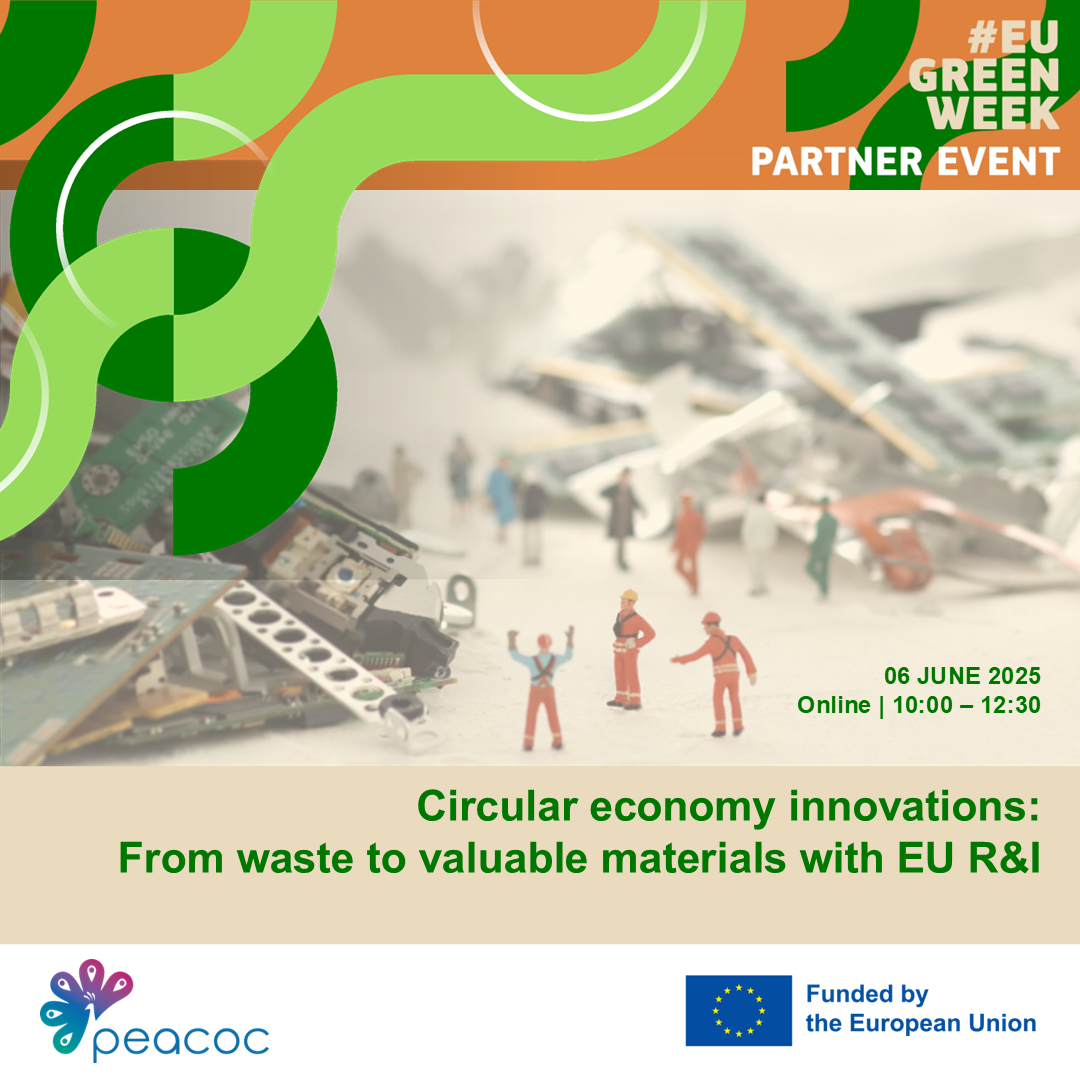
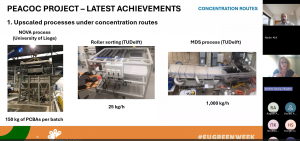

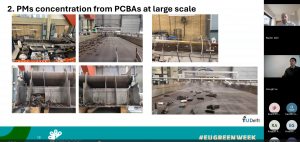

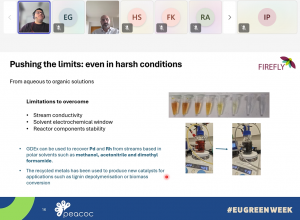
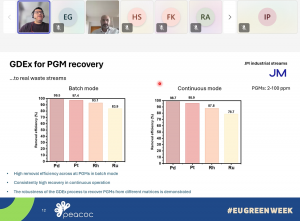
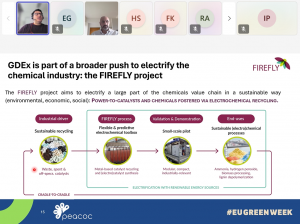
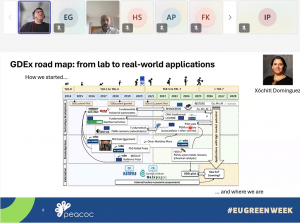
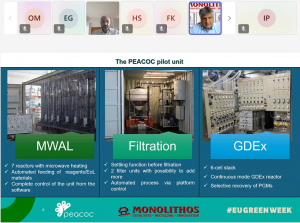
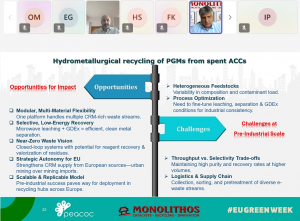
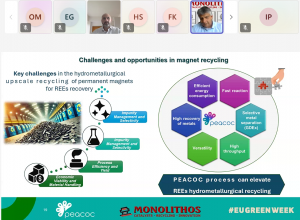
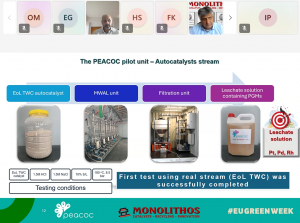
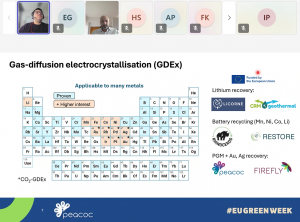
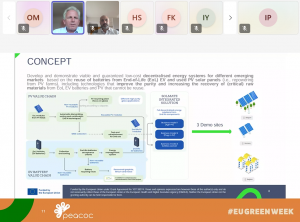
 This
project has received funding from the European Union’s
Horizon 2020 research and innovation programme under grant
agreement No 958302.
This
project has received funding from the European Union’s
Horizon 2020 research and innovation programme under grant
agreement No 958302.